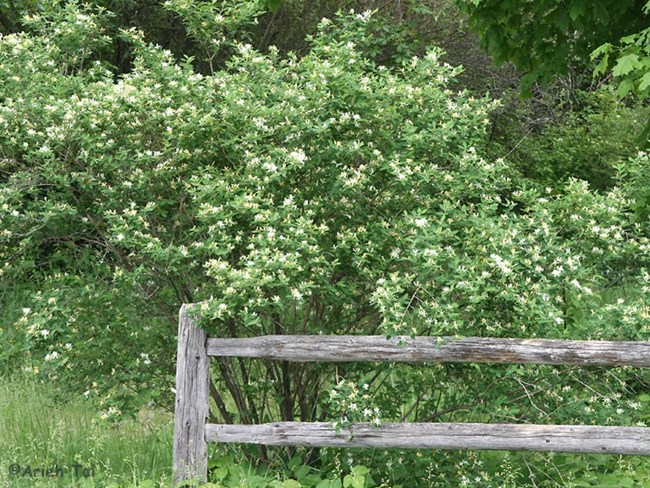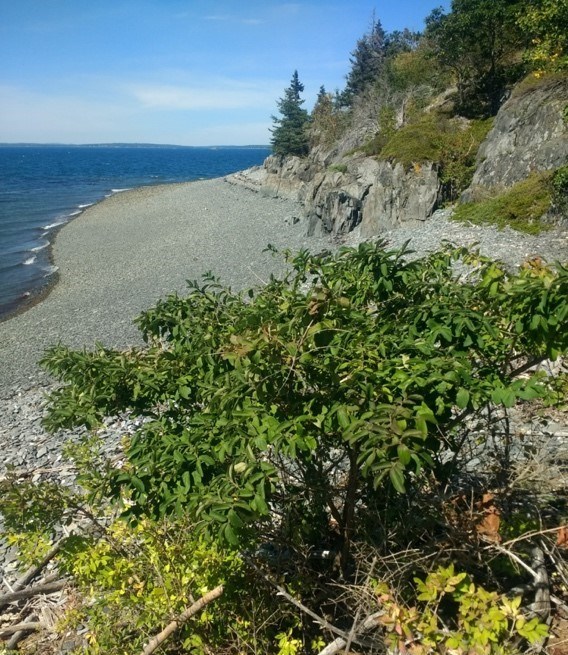Last updated: August 27, 2020
Article
Invasive Plant Profile: Morrow's Honeysuckle

Photo courtesy of Go Botany, https://gobotany.nativeplanttrust.org/species/lonicera/morrowii/
By Sophia Cameron, Invasive Plant Management Intern and Jesse Wheeler, Vegetation Program Manager
Morrow’s Honeysuckle (Lonicera morrowii) is an invasive plant species managed at Acadia National Park. It is often grouped with other species of invasive honeysuckles (L. tatarica, L. x bella), often called Exotic Bush Honeysuckles since they are difficult to distinguish from one another. They are deciduous shrubs found throughout the park, characterized by oppositely branched stems, and opposite, simple leaves. They produce yellow, white, and sometimes pink flowers, as well as round, red, and orange berries.
The berries can be used to distinguish these invasive honeysuckles from native honeysuckle species. For example, the flowers of the native honeysuckle, L. canadensis, are yellow or green, and always downturned. They grow in pairs, as do their red fruits. L. morrowii’s flowers are upturned and grow individually from one another. These shrubs can grow up to approximately ten feet tall, with many stems growing from a single stump. The bark is shaggy on older stems and the stem center (pith) is hollow.

NPS Photos

NPS Photo
Plant Origin
Shrubby Honeysuckles are originally from Asia, specifically Japan. The first recorded collection and introduction into the U.S. occurred in 1852 by Dr. James Morrow, for which Morrow’s Honeysuckle is named. Honeysuckles were imported as decorative species used in gardens, for erosion prevention, and as windbreaks. These are also the reasons why they are so successful as an invasive species.
Why is it Invasive?
They do well in almost every soil type, and can develop complex root systems fairly quickly, making them difficult to remove, or be damaged by storms. Their bright berries are also extremely attractive to native wildlife—particularly birds—although the fruit is not nutritionally valuable to them. Birds help spread the seeds over long distances.
Honeysuckles have been shown to cause a loss in plant diversity, especially herbaceous species, low growing shrubs, and tree seedlings, primarily by blocking out sunlight. However, some studies have led researchers to believe that honeysuckle may release a toxin into the soil from their roots that would harm surrounding vegetation, preventing their growth.
Management at Acadia
Morrow’s honeysuckle is most problematic in old fields and new forests at Acadia, including outer islands like the Porcupine islands, abandoned fields, and old waste sites. The Invasive Plant Management Team at Acadia is continually managing invasive honeysuckle growth. This is done through routine cutting, and root removal, as well as with herbicide application, typically performed early in the summer season before the shrubs become fruit-bearing, to minimize their spread the following season.
Public Action
Help us keep the invasive Morrow’s Honeysuckle out of Acadia by reporting any bushes you see in the park to the Invasive Plant Management Team. Refrain from picking berries or flowers, as this may promote dispersal and pollination. Plant native shrubs and wildflowers in your gardens and remove honeysuckle and other invasive plants from your property.
Honeysuckle Management
Left image
Before honeysuckle management near Ledgelawn Ave, 2013
Credit: NPS Photo
Right image
After honeysuckle management near Ledgelawn Ave, 2013
Credit: NPS Photo
Native Plant Resources
Gardening to Conserve Maine’s Landscape: Plants to Use and Plants to Avoid
Native Plant Trust
Contact Info:
Jesse Wheeler
jesse_wheeler@nps.gov
207-288-8722
References
Love, Jason Patrick. 2006. “Effects of Morrow’s Honeysuckle Control and the Impact of the Shrub on Invertebrates at Fort Necessity National Battlefield, Pennsylvania.” Graduate Theses, Dissertations, and Problem Reports, May. https://doi.org/10.33915/etd.2362.
